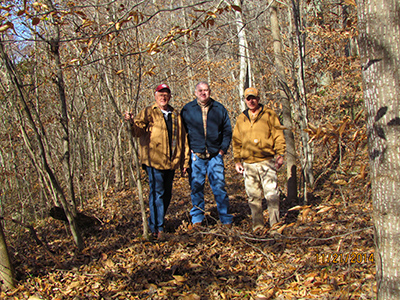Knox Historical Museum President Michael C. Mills along with Steve Valentine and Doug Bargo continue their research and location of the Old Daniel Boone Trace in Knox County.
 The earliest Boone Trace research in Knox County was done by Elmer Decker in 1939. He found that early maps showing trails in Knox County such as the Warriors Path, Boone Trace and Wilderness Road were very inaccurate and misleading. To quote Decker he said that "failure to investigate Knox County records and deeds have led Historians astray.
The earliest Boone Trace research in Knox County was done by Elmer Decker in 1939. He found that early maps showing trails in Knox County such as the Warriors Path, Boone Trace and Wilderness Road were very inaccurate and misleading. To quote Decker he said that "failure to investigate Knox County records and deeds have led Historians astray.
Elmer Decker's research found that when names such as Old Trace and Old Wilderness Road were used in Knox County Deeds, Boone Trace was the route referred to, also when Old State road is mentioned it most ofter refers to the Wilderness Road.
Decker found that some Kentucky Historians believed the Boone Trace passed up the Middle Fork of Richland Creek but Decker cites several local Knox County Deeds which proved this to not be true.
New research today by the Museum is not only proving Elmer Decker's research to be correct but also finding new areas throughout Knox County were the Old Boone Trace once passed.
As a result of New Research with Deeds at the Knox County Courthouse, we have been able to correct a long standing misconception that Knox Counties oldest pioneer roads took different routes across Knox County when leaving Flat Lick.
It is true that the Old Warriors Path, the Boone Trace and the Wilderness Road took the same route from the Cumberland Gap to Flat Lick. However, it is not true that the three routes took different directions when leaving Flat Lick. While all Historians agree that the Warriors Path did leave Flat Lick by way of the Trace Fork of Stinking Creek.
New research by Historians such as Neal O. Hammon, Tom Shattuck and Randell Jones along with local research by Michael C. Mills and the Knox Historical Museum Staff can now prove that the Boone Trace and later Wilderness Road did not separate at Flat Lick but did continue in a Westerly direction across Knox County to the Bimble Community.
The Daniel Boone Trace was blazed across present Knox County in 1775 entering the County from the South on Route 3085 passing the mouth of Ely Hollow and crossing Pogue Hollow and down into Sandy Branch into Flat Lick, also, Route 3085. The Trace exited Old Flat Lick just North of the Evergreen Cemetery. The Old Trace next followed closely the present Route of Highway 25E toward Barbourville, passing the mouth of Stinking Creek and Turkey Creek. After leaving turkey Creek the Trace passed through a narrow gap which once was known as Baughman Kentucky and into the South entrance of Bimble Kentucky Route 3439. On the old Bimble road and before reaching the intersection of Old 25E and Route 1304 near Callihan Loop. The Boone Trace and later Wilderness Road climbed up and over what old deeds call Rasnick Ridge through a Low Gap (see photos) and just over this ridge the Boone Trace and later Wilderness Road take different routes.
The Trace of 1775 continued West up Shy Mug Hollow while the later Wilderness Road of 1796 turns toward Route 1304 through Bargo Loop and toward Girdler.
The Trace near the back of Shy Mug Hollow crosses over into Hammons Gap and into Trace Branch of Little Richland Creek and then follows present Highway 11 South to Heidrick. Near here crossing Little and Big Richland Creeks over to the present CSX Railroad bed and then following this Route South of the Communities of Bailey Switch, Emanuel and Poplar Branch. Then near Arkle, Rossland and Gray the Trace exited Knox County through Routes 223 and 830 and continued onto Route 229 and into present laurel County
(More Boone Trace and Wilderness Road research to come)
The Old Boone Trace passes through the entirety of 5 Kentucky Counties. Knox County is one of these Counties.
The Museum Staff invites anyone with an interest in researching the Boone Trace and later the Wilderness Road to come join us Wednesdays 10:00 a.m. – 4:00 p.m.
Call us: 1-606-546-7581
Visit us on line: www.knoxhistoricalmuseum.org
